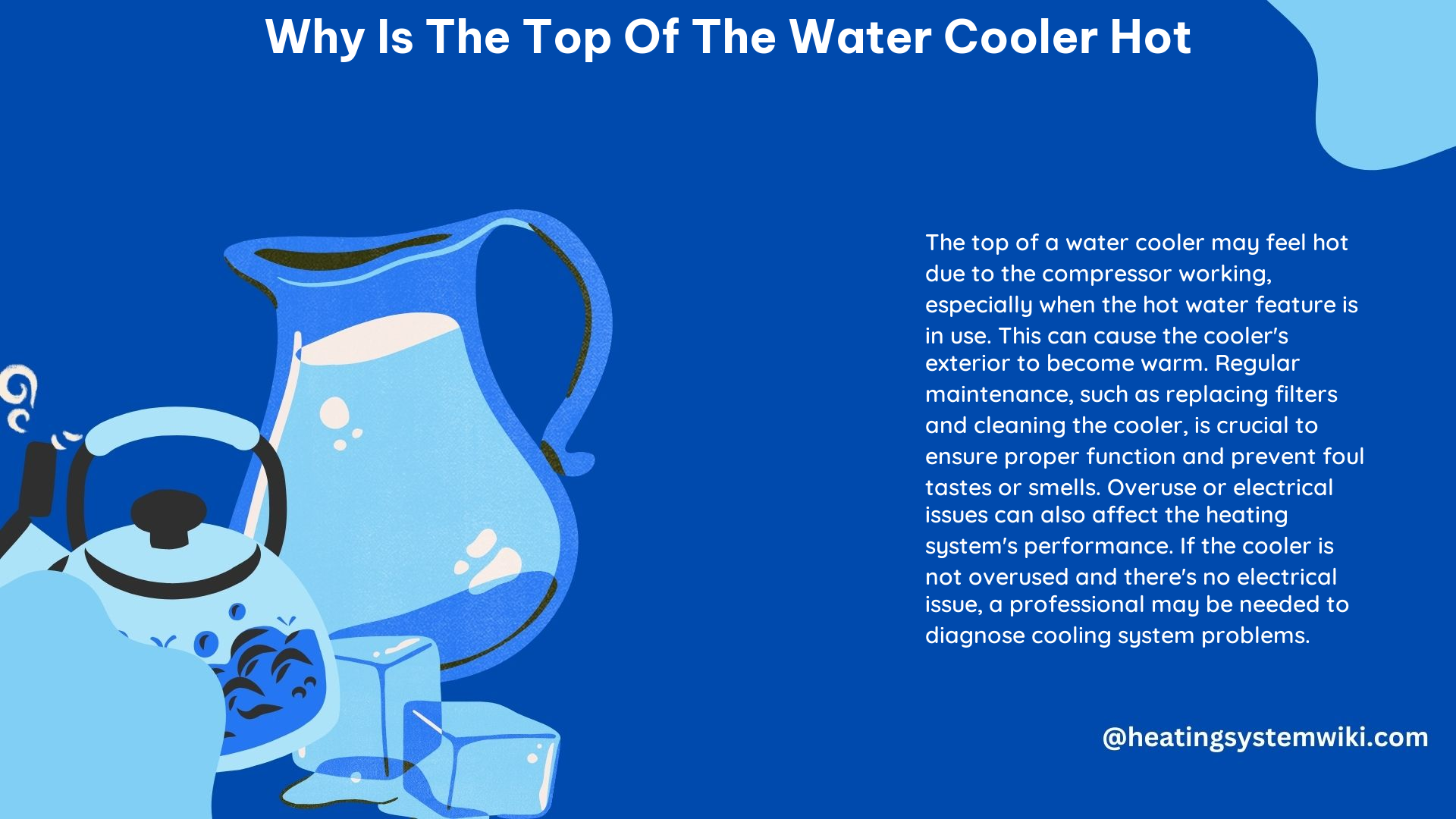The top of a water cooler may feel hot due to a few reasons, primarily related to the cooling system and power supply. This comprehensive guide will dive into the technical specifications, causes, and step-by-step DIY troubleshooting for this issue.
Technical Specifications
Cooling System
A water cooler’s cooling system consists of several key components:
- Compressor: The compressor is the heart of the cooling system. It compresses the refrigerant gas, increasing its temperature and pressure.
- Condenser: The condenser is responsible for dissipating the heat generated by the compressor. As the hot, high-pressure refrigerant gas flows through the condenser, it releases heat and condenses into a liquid.
- Expansion Valve: The expansion valve is a metering device that controls the flow of the liquid refrigerant into the evaporator. As the refrigerant passes through the valve, it expands and cools down.
- Evaporator: The evaporator is where the cooling process takes place. The cold, low-pressure refrigerant absorbs heat from the water, causing the water to cool down. The refrigerant then turns back into a gas and returns to the compressor to repeat the cycle.
The efficient operation of these components is crucial for maintaining the desired water temperature in the cooler.
Power Supply
Water coolers require a stable and consistent power supply to function correctly. Any fluctuations or issues with the power supply can cause the water cooler to overheat or underperform, affecting the temperature of the water and the top of the unit.
Why Is the Top of the Water Cooler Hot?

There are several reasons why the top of a water cooler may feel hot:
- Faulty Cooling System:
- Compressor Issues: If the compressor is not functioning correctly, it may not be able to effectively compress the refrigerant, leading to a breakdown in the cooling cycle and causing the top of the water cooler to overheat.
- Condenser Problems: A malfunctioning or clogged condenser can prevent the hot, high-pressure refrigerant from dissipating heat efficiently, leading to a buildup of heat and a hot top.
- Expansion Valve Malfunction: If the expansion valve is not regulating the flow of refrigerant properly, it can cause an imbalance in the cooling system, resulting in a hot top.
-
Evaporator Failure: A faulty or blocked evaporator can prevent the refrigerant from effectively absorbing heat from the water, causing the top of the cooler to become hot.
-
Power Issues:
- Voltage Fluctuations: Inconsistent or fluctuating power supply can cause the water cooler’s compressor and other components to work harder, leading to overheating and a hot top.
-
Electrical Overload: If the water cooler is connected to a circuit that is already overloaded with other appliances, it may not receive the necessary power, causing the top to become hot.
-
Overuse:
- Excessive Demand: If the water cooler is being used excessively, the cooling system may not be able to keep up with the heat generated, causing the top to feel hot.
-
Frequent Openings: Repeatedly opening the water cooler’s door or spigot can disrupt the cooling cycle, leading to a hot top.
-
Lack of Maintenance:
- Buildup of Bacteria and Gunk: If the water cooler is not properly cleaned and maintained, the accumulation of bacteria, mineral deposits, and other contaminants can interfere with the cooling system’s efficiency, resulting in a hot top.
- Clogged Filters: Dirty or clogged filters can restrict the flow of water and air, reducing the cooling system’s effectiveness and causing the top to become hot.
DIY Troubleshooting
If you’re experiencing a hot top on your water cooler, try the following DIY troubleshooting steps:
- Reset the Power:
- Unplug the water cooler from the power source and wait for 30 seconds.
-
Plug the water cooler back in and observe if the top temperature returns to normal.
-
Check for Overuse:
- Reduce the frequency of use or the number of people using the water cooler to allow the cooling system to catch up.
-
Avoid opening the door or spigot unnecessarily to maintain the cooling cycle.
-
Maintain the Water Cooler:
- Clean the water cooler’s interior and exterior regularly to remove any buildup of bacteria, mineral deposits, or gunk.
- Replace the water filters as recommended by the manufacturer to ensure optimal water flow and cooling efficiency.
- Perform a deep cleaning of the entire water cooler system at least once every six months.
If the hot top persists after trying these DIY troubleshooting steps, it may be necessary to contact a professional technician for further diagnosis and repair.
